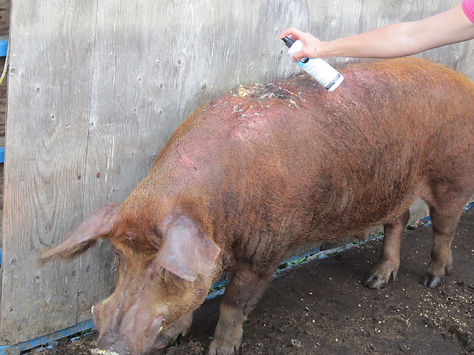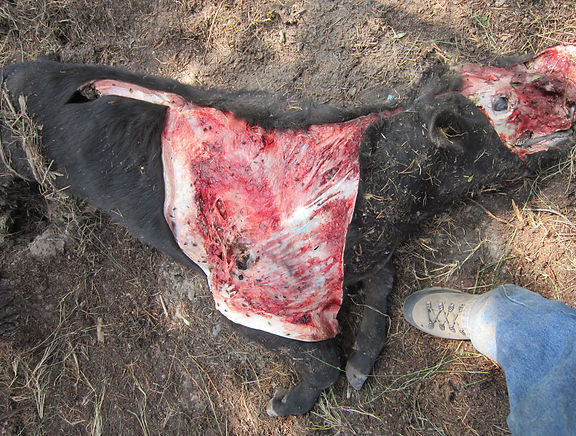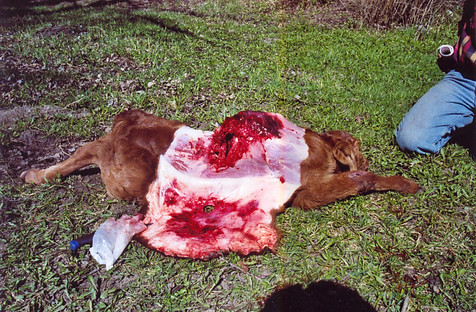What Killed My Animal?
The following is a basic outline and general examples of some predatory habits of Bears on domestic livestock and pets
Bear
Being the largest of the North American predators, when it comes to the predation of livestock and pets, bears will demonstrate larger amounts of power and trauma inflicted on the prey animal as well as larger amounts of tissue consumption in a shorter period of time. That being said, bears (the same as each of the predators) will utilize preferred techniques that are programed within them. Regardless of the size of the bear or size of the prey, bears will typically utilize the same technique. Cattle, sheep, pigs, goats and horses are included but not exclusive of the domestic stock that bears have been known to prey on.
Bear and cougar, typically being solitary predators, (at least while killing) do share a few habits that can be observed with prey that have been killed by either predator. These include:
-
Both predators have been known to kill multiple domestic prey animals during one attack
-
Both predators will drag or carry a prey animals out of open areas toward areas of cover such as brush or timber
-
Both predators are known to cover the kill with debris from around the site they have stored the carcass, such as grass, leaves, sticks, moss etc.
-
Both predators are known to stay close to the kill and in some cases, defend it.
General habits of bears while preying on livestock and pets:
-
Typical attack site on the prey animal will be from above, with damage from bites down into the shoulders and back. This area of damage can range from the neck to the hips with smaller or more inexperienced bears, however the more experienced the bear, the more localized to the shoulder or withers the damage will be and the more efficient the attack will be .
-
Larger prey such as full grown cattle preyed upon by larger bears, will often have a bite over the bridge of the nose and face
-
Bears are typically shy eaters, so victim carcasses will be drug or carried to areas of cover where the bear may hide, such as heavy brush or timber where the carcass will often (but not always) be covered with whatever material is available.
-
Surface debris like sticks or moss to actual heavy sod and dirt can be used to fully bury the remains
-
Unless discovered or disturbed shortly after the attack, bears are known for large amounts of consumption in short periods of time; when compared to cougar and less than a large pack of wolves
-
Bears are known to lay claim to carcasses that have died of natural causes or even one killed by other predators, which emphasizes the need for a detailed inspection prior to assigning blame to a bear that has claimed the remains of an animal.
Calf attacked by a bear when the owner intervened. Although the calf survived the attack, it was paralyzed as a result of the damage. Young calf showing very typical attack pattern from a younger bear, with damage toward the hips more than usual. Bites and holes not readily obvious from the outside while the extent of the trauma is clear upon skinning back the area of damage.



Two sheep killed by Black Bear. Sheep were drugged into corner of pasture and fed on, however the owner disturbed the scene and the bear moved off.



Although feeding over the ribs and back area was substantial, the trauma over the withers is still obvious once the hide is skinned back


New born calf preyed upon by a young Black Bear, with bites over the withers, neck and head. Marks on the head are more typical of results from the bear dragging or carrying the carcass away.






Large swine attacked by bear with the typical attack pattern. Survival of this particular animal is attributed to the overall size of the animal and the tusks it possesses.



Large yearling steer killed by a Grizzly Bear, dragged into the treed area and buried. Animal is uncovered, withers are skinned back to show bites and trauma resulting from the attack






Damage to the bridge of the nose from the face bite that is typical of attacks on larger prey animals.
Young calf killed by Black Bear.



Young calf found by producer while bear was in the process of attacking it. Bear fled due to producers attendance. Calf was euthanized by producer due to the damage inflicted during the brief attack.


